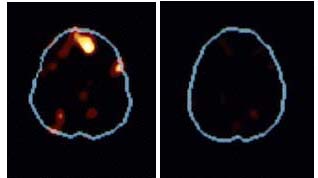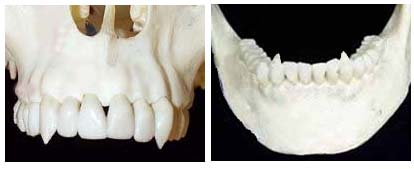The Science of Vampirism
Extended Edition: Part IV
By Robert LomaxVampire Biology
Brain & Nervous System
 |
|
A normal brain (left) shows serotonin activity. A vampire brain (right) shows none. |
Dopamine/Endorphins: These neurotransmitters induce feelings of euphoria, and are released in a vampire's brain when it feeds. Neural pathways activated in feeding vampires are much like those found in drug users. In fact, vampires are highly susceptible to drug addiction, which can occur simply by drinking the blood of an addict. Cocaine and opiates (such as morphine and heroin) can mitigate a vampire's hunger by altering its dopamine and endorphin receptors, causing it to become lethargic and disinterested in hunting. This also causes its pupils to contract, inhibiting its keen night vision. A vampire that continues to indulge in drugs will die from malnutrition in a matter of weeks. For more information, see the 1880 case of the opium vampires.
Circadian Rhythms: Chemical changes in the brain that help us "rise and shine" with the morning light are reversed in vampires.
Extrasensory Perception: Compared to humans, vampires are perceptive to the point of bordering on precognition. One researcher identified the source of this ability as enlarged amygdalae—a pair of almond-shaped nuclei located deep within the brain, devoted to processing, memory, emotional reactions and identifying danger. This is thought to be an adaptive change that allows vampires to anticipate danger before it's manifest, resulting in faster reflexes. It also helps them figure out what people are thinking based on certain cues: eye and muscle movement, mannerisms, vocal tone, breathing, flushing of the skin, pulsating vessels, perspiration, etc.
Photosensitivity: Vampires are very sensitive to all light, but the ultraviolet rays emitted by the sun cause them special problems: UV light that enters a vampire's eyes sets off a chain reaction in their brain that leads to violent convulsions, which can be fatal for vampires stuck out in the sun for too long. Even if a vampire were to close its eyes, the lids just aren't thick enough to block out these harmful rays (which is also why people who spend time in tanning beds wear special goggles). However, there are sunglasses now that provide near-perfect protection from UV light.
Sense Organs
 |
| A normal eye compared with a vampire's. |
 |
| A vampire's glowing retinas. |
Smell/Hearing: Both senses are extremely acute: thanks to a combination of increased neural sensitivity and additional receptor cells, hearing range is tripled while smell is tenfold. There is a downside to this, as vampires are much more sensitive to pepper spray, air horns and the sound of gunfire. They can also hear dog whistles, and other high-frequency noises that human ears can't pick up. Over time, fluid loss causes the cartilage of the ear helix to shrink and take on a somewhat pointed appearance.
Taste/Touch: Despite the fact that vampires experience less blood flow in their epidermal tissues, their nerve endings are actually much more sensitive than a human's. This greatly improves their balance and reflex action, and the taste of human blood is much sweeter to them. Unfortunately, this also makes physical sensations such as touch, heat, cold and the feeling of water quite uncomfortable for them—not unlike those suffering from autism. Pain, however, is somewhat dulled. Similar to a drowning victim, vampire gums take on a ghastly bright-purple color, while the tongue is a more deep purple.
Hair, Skin, Teeth & Nails
 |
|
As you can see, the upper fangs are quite straight compared to the curved lower fangs. |
Dental Regeneration: Vampires who have had their teeth pulled out—both before and after transformation—have been observed to regrow their top and bottom canines within a month (while having to rely on knives in the meantime). Unfortunately, these replacement fangs are thinner and don't protrude as much, which makes feeding a bit more difficult. Since even the slightest damage is repaired, vampires are incapable of getting permanent cavities in their fangs, and they'll have to keep filing them to keep them sharp. If the vampire has a dental implant (which is screwed into the jawbone), then no regeneration will occur, since the root canal is effectively destroyed by a drill prior to implantation.
 |
|
Close-up of a vampire's skin and veins. Date: 1971. |
Scent: Vampires bear a strong, unpleasant odor reminiscent of ammonia. Because vampires don't urinate that often, toxins build up in their bloodstream and into their sweat, causing a stench that worsens as bacteria grows in it. Natural pheromones only add to the aroma. Before venturing out in public, they'll take great pains to bathe themselves and cover their scent with deodorants, colognes and perfumes. If you've ever smelled musky cat urine, then you'll know the foulness of an unwashed vampire.
 |
|
Wound inflicted by a jagged vampire claw. Those from pointed claws are more narrow and deep. |
 |
|
A 68-year-old vampire suffering from the effects of UV exposure after a failed suicide attempt; 1942. Note the pointed ears and lack of hair. |
Hair: Hair growth slows down substantially—closer to the rate of human nails. For instance, while it takes about a day or so for stubble to appear after a human shaves, it can take almost a week for a vampire. Because vampire nails use more protein, the growth speed of both tissues is drastically reversed. Not only that, once a follicle reaches its terminal length and falls out, each regrowth will become smaller and lighter until it's gone for good. Since blood supply is also a factor, the extremities are the first to go completely, while other areas simply become patchy. Next up is torso and facial hair—including the eyebrows, eyelashes and nasal hair. Then what's left on the scalp will disappear as well. Within ten years of transformation, a vampire's entire epidermis will be completely bald, with not even a hint of peach fuzz. Some vampires will cut or shave their hair before it's all gone, while others will simply yank it out with their bare hands. To disguise their alopecia, vampires will take to wearing wigs, hats and hoods over their naked scalps. They've also been known to glue on synthetic eyebrows and eyelashes, as well as mustaches, goatees and beards.

No comments:
Post a Comment